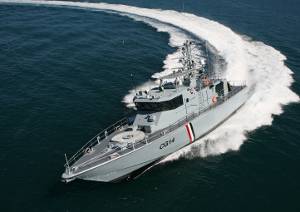
Austal has delivered six high-speed aluminum patrol craft to Trinidad and Tobago Coast Guard (TTCG). Capable of speeds greater than 40 knots and armed with general purpose machine guns and a 20mm cannon, the 98.4 ft vessels, designed and built by Australian shipbuilder Austal, will expand the TTCG’s surveillance and enforcement capability in the region.
The on‐schedule, on‐budget delivery of the fleet was achieved less than two years from the initial order, with the final vessels arriving in Trinidad and Tobago via heavy lift ship on January 18.
Austal is now set to deliver a five‐year comprehensive maintenance and support services program for the vessels as part of an additional contract. Included in this will be scheduled planned and preventative maintenance support, unscheduled maintenance, management and performance of annual surveys and maintenance periods, as well as shore based engineering support.
Specifications:
Hull Form Monohull
Deadweight (max) 16 tonnes
Length, o.a. 98.4 ft
Length, waterline 80.7 ft
Beam, moulded 21 ft
Depth, moulded 10.5 ft
Draft, approx. 1.5 metres
Crew capacity 11
Range at 10 knots >1000nm



